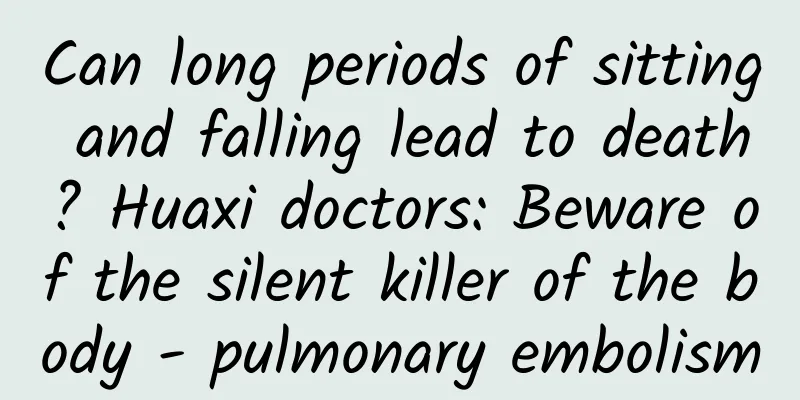Can long periods of sitting and falling lead to death? Huaxi doctors: Beware of the silent killer of the body - pulmonary embolism

|
Is this also the case with you in life? ============== Friends gather together and set up the mahjong table Staying put all night, try your best to turn a bicycle into a motorcycle I stayed at home all day during the holiday, and I didn't move if I could lie down. After sitting on the train for more than ten hours, I felt numb but insisted on persisting After major or minor surgery, lying down and resting thought everything was fine. … Be careful! Pulmonary embolism Maybe it's lurking around you. Related cases have been reported An accidental sprain can lead to cardiac arrest! turn out to be All this is caused by pulmonary embolism, killing people invisibly Image source: Weibo screenshot of Daily Economic News Today, Dr. Huaxi will introduce you to this The Silent Killer: Pulmonary Embolism Pulmonary embolism is known as "one of the top ten cardiopulmonary diseases that need to be solved in the 21st century". Severe acute pulmonary embolism can cause sudden death within a few seconds . If acute pulmonary embolism is not treated promptly and in a standardized manner, it may also lead to chronic pulmonary embolism and chronic thromboembolic pulmonary hypertension, eventually leading to heart failure and endangering life . Copyright image, no permission to reprint When many people hear about cardiopulmonary diseases, they may subconsciously think that they only occur when they are old. In fact, this is not the case. Pulmonary embolism has a high incidence, high mortality, and high misdiagnosis rate . It is not selective in age, gender, or race. It can occur at any time and anywhere . It can even hit people suddenly before the body has any symptoms, and eventually kill them. Especially for hospitalized patients, the severity of pulmonary embolism is no less than that of myocardial infarction and cerebral infarction. 60% of pulmonary embolism cases are related to hospitalization. Having said the dangers of pulmonary embolism, what exactly is it? In fact, you can probably tell from its name that pulmonary embolism refers to: various "emboli" blocking the pulmonary artery system, thus leading to pulmonary circulation and respiratory dysfunction. It is a critical and severe disease with a very high mortality rate . These "emboli" are mainly blood clots , and less commonly amniotic fluid, air, etc. Blood clots usually originate from the deep veins of the lower limbs and pelvis. After falling off, they circulate through the blood and travel all the way to the heart, then block the pulmonary artery. We can imagine blood vessels as "rivers". Under normal circumstances, they meander. The occurrence of blood clots is like "stones blocking the river". Once blood vessels are blocked, the blood transport system will be paralyzed, and the consequences will be disastrous. The formation of thrombus is inseparable from three factors: blood stasis, vascular wall damage (or endothelial damage) and hypercoagulable state . When people sit or lie still for a long time, the blood in the lower limb veins will return too slowly, causing blood stasis. Surgery, trauma, inflammation, etc. can cause damage to the vascular wall structure or endothelium, leading to vasoconstriction, platelet adhesion and aggregation, etc. The hypercoagulable state can be understood as a state in which the blood is easy to coagulate and form thrombi. These three work together to form a blood clot. Blood clots may form in veins in any part of the body. If you stand up or exercise suddenly, the blood clots may flow with the blood and enter the pulmonary circulation, causing pulmonary embolism. Although pulmonary embolism can happen to anyone at any time and anywhere, regardless of gender, age, or race, the following high-risk groups need our special attention: From no symptoms to syncope and even sudden death The clinical symptoms of pulmonary embolism vary. "All kinds? Doctor, please help me. I've been losing a lot of hair lately. Is it a pulmonary embolism?" Pulmonary embolism: Don’t get involved Pay attention, if high-risk groups have the following symptoms: Notice! Be alert to the occurrence of pulmonary embolism! Go to the hospital immediately! The bad news: Pulmonary embolism is dangerous and has a very high mortality rate. The good news: It is preventable! In daily life, doing these things can prevent ↓↓↓ Stand up and move around more . Whether you are working at a desk, studying, or traveling for a long time on a train or high-speed rail, you should move your legs from time to time and walk a few steps to prevent the blood from returning too slowly in the veins of the lower limbs, which may cause thrombosis. Drinking more water helps dilute the blood and promotes healthy blood circulation. Good blood circulation makes it less likely to form blood clots. Control blood sugar and blood lipids to avoid high blood viscosity Quit smoking and maintain good living habits For patients with special risks, such as those who need to stay in bed for a long time due to illness or surgery, doctors generally use device prevention , such as gradient compression stockings, intermittent pneumatic compression devices, plantar venous pumps, etc., to promote blood return to the lower limbs . For patients with higher risk, anticoagulant drugs will be used for prevention, and if necessary, anticoagulant drugs combined with device prevention will be used . all in all Although pulmonary embolism is dangerous, it is preventable and treatable. One sentence↓↓↓ Get moving! Don't let pulmonary embolism affect your health Statement: This article is a medical-related educational popular science article. It does not involve specific treatment methods or medical behaviors and cannot replace hospital visits. About Pulmonary Embolism What other information would you like to know? You can leave a message in the comment area Experts collaborating on this article References 1. Yi Qun, Yan Yu, Zhou Haixia, et al. Antithrombotic therapy for pulmonary embolism: Unraveling the underlying diseases and clinical complexities[J]. Chinese Medical Journal, 2017, 97(36): 2806-2809. DOI: 10.3760/cma.j.issn.0376-2491.2017.36.003. 2. He Jianguo, Cheng Xiansheng. Advances in diagnosis and treatment of pulmonary embolism[J]. Chinese Journal of Tuberculosis and Respiratory Diseases, 2000, 23(9):563. DOI:10.3760/j:issn:1001-0939.2000.09.034. 3. Li Jianhong. Clinical analysis of pulmonary embolism misdiagnosed as acute non-Q wave myocardial infarction[J]. Hainan Medicine, 2008, 19(7): 97-98. DOI: 10.3969/j.issn.1003-6350.2008.07.055. 4. Zeng Guojun, Zhou Haixia, Li Xi. She stumbled and received a critical illness notice[J]. Health Expo, 2019(12):17-19. |
Recommend
Dell's new Venue 8 tablet is a pure Android tablet
Since Google launched Nexus 7, more diverse sizes...
OLED displays are already on the market. Can quantum dots still become popular?
Walking into the electronic mall, we can see that...
With its performance plummeting, will Nikon become the next Kodak?
In the 1970s, American imaging giant Kodak invente...
For the first time in history! Audi voluntarily admits monopoly: willing to be punished
The Economic Information Daily reporter learned o...
Hard to guard against! How realistic can AI scams be?
Digital life, online communication, electronic co...
Will Xiaomi and Midea "divorce"?
Xiaomi and Midea got married without dating each ...
How to plan a large event? Here are 6 basic elements
Before planning an event , ask yourself, why do y...
When will the Quanzhou, Fujian epidemic end in 2022? When will the ban be lifted? Attached is the latest news on the epidemic
Recently, local outbreaks have occurred in Quanzh...
Xiaofei Training Camp 10th issue Baidu Cloud download
Resource introduction of Xiaofei Training Camp 10...
Welfare for the elderly: It is no longer difficult for the elderly to use mobile phones. Mobile phones are suitable for the elderly and barrier-free transformation is here.
It is becoming more and more convenient for young...
He has been gone for many years, but we still miss him...
If you were a drop of water Have you moistened an...
Trivia | Can you continue a dream that you haven’t finished the next day?
Control material method. The most common material...
With an Apple SIM card, iPad can access mobile Internet in more than 90 countries
Apple has launched the "Apple SIM" pro...
How much does it cost to rent a 100M bandwidth server in Henan per year?
Bandwidth is the most important and critical link...
Duck Neck was fined 600,000 yuan. Can vulgar marketing and low-level mistakes be avoided?
There have been quite a few advertisements punish...









